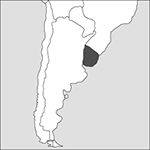
Source: MAPS IN MINUTES™ © RH Publications (1997)
Capital:
Montevideo
Area:
176,215 sq km (68,037 sq miles)
Population:
3,324,460 (2013 est)
Currency:
1 Uruguayan peso = 100 centésimos
Religions:
Roman Catholic 47.1%; other Christian 11.1%: Jewish 0.3%
Ethnic Groups:
White 88.0%; Mestizo 8.0%; Black 4.0%
Languages:
Spanish (official), Portunol
International Organizations:
UN; OAS; Mercosur; WTO
A country in south-east-central South America with a coast on the Atlantic bounded by Argentina on the west and Brazil on the north-east.
Physical
Uruguay has a coast on the estuary of the River Plate, and the Uruguay River flowing down its western boundary is navigable for some 320 km (200 miles). Tributaries flow westward across the country, which is mainly warm, grassy plain (pampas) supporting cattle and sheep. In the centre and north-east the plain is broken by occasional rocky ridges.
Economy
Uruguay’s major exports are agricultural products: beef, soya beans, cellulose, rice, wheat, wood, dairy products, and wool. Food processing is the principal industry; other industries include electrical machinery, transportation equipment, and oil products.
History
Uruguay was inhabited by various indigenous peoples, such as the Chaná and Charnía, prior to the arrival of Spanish and Portuguese colonists in the 16th century. During the colonial period, it was known as the Banda Oriental and became a part of the Spanish vice-royalty of Rio de la Plata. In 1814 the leaders of the Banda Oriental, notably Artigas, broke with the military junta in Argentina and led a struggle for Uruguayan independence until occupied by Brazil in 1820. In 1825 an independent republic of Uruguay was declared, which was recognized by the treaty between Argentina and Brazil, signed at Rio de Janeiro in 1828. Under a republican constitution, the liberals (Colorados, redshirts) and the clerical conservatives (Blancos, whites) struggled violently throughout the 19th century for political control. In 1872 the Colorado Party began a period of 86 years in office. During the first three decades of the 20th century, José Batlle y Ordóñez, while in and out of the presidency, helped mould Uruguay into South America’s first welfare state. Numerous measures for promoting governmental social services and a state-dominated economy were enacted. In 1958 the elections were won by the Blanco Party. Economic and political unrest plagued the nation throughout the 1960s and saw the emergence of the Marxist terrorist group, the Tupamaros. The military took over in the 1970s, and a return to civilian rule took place in 1985, when Julio Sanguinetti became President. After a long campaign he won a referendum in 1989 in support of an Amnesty Law for political prisoners from the military regime of 1973 to 1985. In 1990 Luis Alberto Lacalle Herrera of the Blanco Party succeeded him, forming a coalition government with the Colorado Party. Sanguinetti was re-elected in 1995 and was succeeded by Jorge Batlle in 2000. In 2005 Tabaré Vázquez became the country’s first left-wing President; he was succeeded in 2010 by José Mujica, a former Tupamaros guerrilla. Renowned for avoiding all trappings of power, Mujica maintained political and social stability, while also introducing radical policies such as the legalization of marijuana and same-sex marriages. In the 2014 elections, Vázquez was again elected president. During the last decade Uruguay has emerged as one of the most prosperous and literate nations in South America.
- James, William (1842–1910)
- James–Stein estimator
- jammer
- jamming
- Janata Party
- JANET
- Janissaries
- Janjukian
- Jansen, Cornelius Otto (1585–1638)
- Jansenism
- jansky
- Jansky, Karl Guthe
- Jansky, Karl Guthe (1905–50)
- Jansky noise
- Janssen, Pierre Jules César
- Janssen, (Pierre) Jules César (1824–1907)
- Janssen, Zacharias
- Janus
- Janus kinase
- Japan
- Japan Aerospace Exploration Agency
- Japanese Constitution (1947)
- Japanese Experiment Module
- Japanese Federation of Statistical Science
- Japanese Meteorological Agency seismic intensity scale